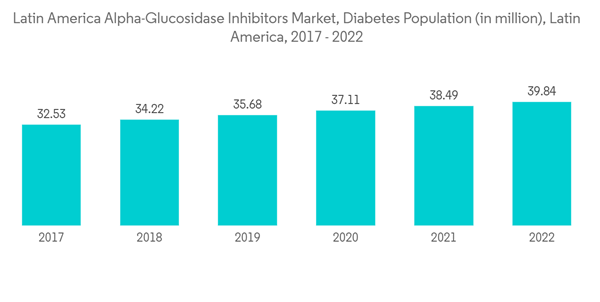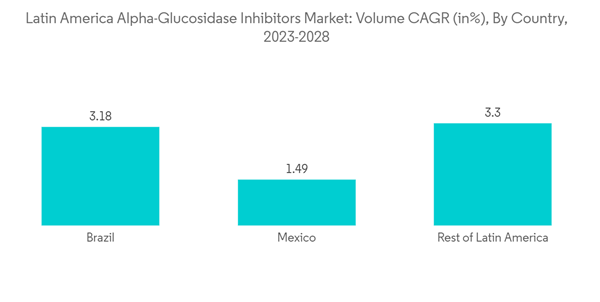The Latin America Alpha-Glucosidase Inhibitors Market size is expected to grow from USD 72.47 million in 2023 to USD 85.24 million by 2028, at a CAGR of 3.30% during the forecast period (2023-2028).
The COVID-19 pandemic has been testing the capacity to respond and adapt to populations, governments, and health systems worldwide. In the Latin America region, Brazil presented the first suspected and the first confirmed cases on January 27th and February 26th, respectively. Most Latin American countries failed to implement timely measures to protect individuals with diabetes, which may severely impact individuals, health systems, and economies.
The diabetic prevalence is high in countries in the Latin American region, and Mexico is known to have a high number of diabetic patients due to the growing prevalence of Type-2 diabetes in the country. The gradually growing obesity rate, combined with the genetic predisposition for Type-2 diabetes, is acted as a prominent driver for the increase in the Type-2 diabetic population over the last 40 years. Currently, close to 10% of the total population is living with diabetes. Diabetic patients in the Latin American region mainly suffer from Type-2 diabetes, and they accounted for close to 90% of the total diabetic population in 2021.
This is driving the demand for Alpha-Glucosidase Inhibitors in Latin America, thereby driving the market in focus during the forecast period.
Factors contributing to this increase include population aging and increased life expectancy, urbanization, and lifestyle changes among Native American populations. Diabetes treatment is available to only a minority of people in many places. Furthermore, type 2 diabetes is frequently diagnosed late in the disease's progression, resulting in 10-40% of patients having chronic complications at the time of diagnosis. Hospital costs account for most direct treatment costs, and diabetes mortality has increased significantly in some areas over the last two decades.
Therefore, the studied market's growth is anticipated in the Latin America Region due to the factors above.
According to Universal Health Coverage 2022, The four nations, including Argentina, Brazil, Colombia, and Mexico, achieved an overall index of essential coverage of 76-77 percent, with households spending less than 25 percent of their income on health care and expanding access to primary healthcare systems and coverage for noncommunicable illnesses enhanced service coverage, while a rise in the number of qualified healthcare personnel enabled community outreach.
AGIs effectively improve the metabolic profile and potentially lower the risk of long-term hyperglycemia complications in patients with type 2 diabetes mellitus. They can be used alone or with other antihyperglycemic medications and insulin. They have no links to any serious negative consequences. This makes them especially useful for patients with renal, cardiorespiratory, or liver issues, who are at a higher risk of developing lactic acidosis and thus are not good candidates for metformin therapy. They also do not cause hypoglycemia, making them a viable alternative to sulfonylureas, which are frequently associated with hypoglycemia. Patients should be counseled on maintaining an appropriate diet, as a high carbohydrate diet can exacerbate gastrointestinal side effects. If used with other anti-diabetic medications, the patient should keep glucose on hand to quickly reverse hypoglycemia. Type 2 diabetes mellitus management necessitates an interdisciplinary approach; the primary care provider, pharmacist, and nurse practitioner should educate patients about side effects and how to maintain an appropriately healthy diet.
The market is expected to grow during the forecast period due to the factors above.
The COVID-19 pandemic has been testing the capacity to respond and adapt to populations, governments, and health systems worldwide. In the Latin America region, Brazil presented the first suspected and the first confirmed cases on January 27th and February 26th, respectively. Most Latin American countries failed to implement timely measures to protect individuals with diabetes, which may severely impact individuals, health systems, and economies.
The diabetic prevalence is high in countries in the Latin American region, and Mexico is known to have a high number of diabetic patients due to the growing prevalence of Type-2 diabetes in the country. The gradually growing obesity rate, combined with the genetic predisposition for Type-2 diabetes, is acted as a prominent driver for the increase in the Type-2 diabetic population over the last 40 years. Currently, close to 10% of the total population is living with diabetes. Diabetic patients in the Latin American region mainly suffer from Type-2 diabetes, and they accounted for close to 90% of the total diabetic population in 2021.
This is driving the demand for Alpha-Glucosidase Inhibitors in Latin America, thereby driving the market in focus during the forecast period.
Latin America Alpha-Glucosidase Inhibitors Market Trends
Rising Diabetes Prevalence in Latin America Region
In Latin America, the incidence of type 1 diabetes ranges from 0.4 to 8.3 cases per 100,000 children under the age of 15, and the prevalence of type 2 diabetes ranges from 1.2% to 8%, with higher prevalence rates in urban areas. Diabetes is expected to increase by 38% in Latin America over the next decade, compared to a 14% increase in the population. By 2025, the total number of diabetes cases is expected to more than double and surpass the number of cases.Factors contributing to this increase include population aging and increased life expectancy, urbanization, and lifestyle changes among Native American populations. Diabetes treatment is available to only a minority of people in many places. Furthermore, type 2 diabetes is frequently diagnosed late in the disease's progression, resulting in 10-40% of patients having chronic complications at the time of diagnosis. Hospital costs account for most direct treatment costs, and diabetes mortality has increased significantly in some areas over the last two decades.
Therefore, the studied market's growth is anticipated in the Latin America Region due to the factors above.
Brazil is Expected to Dominate the Latin America Alpha-Glucosidase Inhibitors Market.
Among the Latin American countries, Brazil dominates around 79% of the total Latin America Alpha-Glucosidase Inhibitors Market. This is mainly due to the high diabetes prevalence in the country. In Brazil, the Brazilian health system is managed by each state and local health secretariat and is governed by the MOH. Furthermore, in many towns where the public sector cannot meet people's requirements, partnerships with private organizations have been put in place to increase access to PHC. The Brazilian health system in Brazil provides coverage to medicines through several programs that include a 20% expanded access to essential medicines. Brazil offers an extensive free immunization program. Brazil faced numerous lawsuits over the last 20 years, demanding the coverage of high-cost drugs to treat diabetes and certain rare or low-prevalence diseases.According to Universal Health Coverage 2022, The four nations, including Argentina, Brazil, Colombia, and Mexico, achieved an overall index of essential coverage of 76-77 percent, with households spending less than 25 percent of their income on health care and expanding access to primary healthcare systems and coverage for noncommunicable illnesses enhanced service coverage, while a rise in the number of qualified healthcare personnel enabled community outreach.
AGIs effectively improve the metabolic profile and potentially lower the risk of long-term hyperglycemia complications in patients with type 2 diabetes mellitus. They can be used alone or with other antihyperglycemic medications and insulin. They have no links to any serious negative consequences. This makes them especially useful for patients with renal, cardiorespiratory, or liver issues, who are at a higher risk of developing lactic acidosis and thus are not good candidates for metformin therapy. They also do not cause hypoglycemia, making them a viable alternative to sulfonylureas, which are frequently associated with hypoglycemia. Patients should be counseled on maintaining an appropriate diet, as a high carbohydrate diet can exacerbate gastrointestinal side effects. If used with other anti-diabetic medications, the patient should keep glucose on hand to quickly reverse hypoglycemia. Type 2 diabetes mellitus management necessitates an interdisciplinary approach; the primary care provider, pharmacist, and nurse practitioner should educate patients about side effects and how to maintain an appropriately healthy diet.
The market is expected to grow during the forecast period due to the factors above.
Latin America Alpha-Glucosidase Inhibitors Industry Overview
The market studied is highly fragmented into many manufacturers like Bayer, SunPharma, Pfizer, and Takeda, holding a presence in Latin America Region.Additional Benefits:
- The market estimate (ME) sheet in Excel format
- 3 months of analyst support
Table of Contents
1 INTRODUCTION
4 MARKET DYNAMICS
5 Market Segmentation
6 MARKET INDICATORS
7 COMPETITIVE LANDSCAPE
Companies Mentioned (Partial List)
A selection of companies mentioned in this report includes, but is not limited to:
- Bayer pharma
- Takeda
- Pfizer
- Glenmark pharma
- Sun pharma
- Torrent
- Unichem
- Hexalag
Methodology

LOADING...










